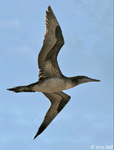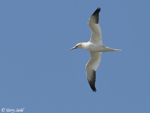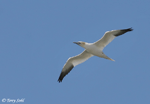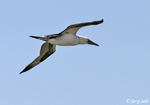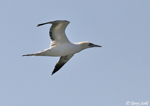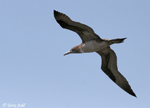Northern Gannet
Morus bassanus
| Length: 36 inches | Wingspan: 72 inches | Seasonality: Non-resident in South Dakota |
| ID Keys: Adults mostly white, dark wingtips, orangish hue on head. Juveniles brownish, achieving mature plunmage in 4th year | ||
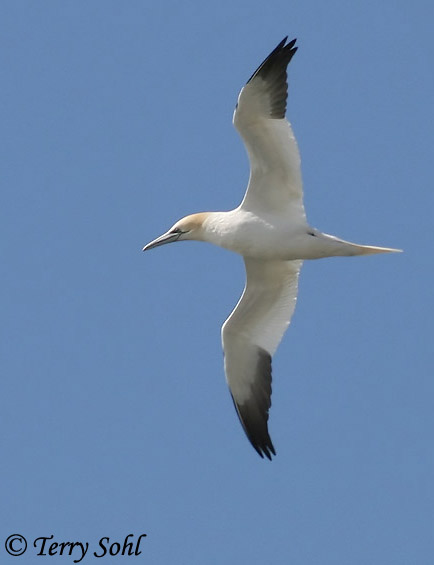 The
Northern Gannet is one of the largest seabirds of the north Atlantic Ocean,
where great nesting colonies can be found on select cliff sites on the
Canadian coastline in summer. At other times of the year, they are scattered
over a wide area across the Atlantic, from as far north as Cape Cod in
Massachusetts, southward to the tropics. Groups of foraging Northern
Gannets are often found where upwelling cold currents concentrate their
favorite fish species. There, Northern Gannets can be seen performing
spectacular plunge dives into the ocean, with high-speed vertical dives
followed by underwater pursuit of their prey. Northern Gannets are
closely related to Booby species, with the Masked Booby and Red-footed Bobby
somewhat similar in overall appearance.
The
Northern Gannet is one of the largest seabirds of the north Atlantic Ocean,
where great nesting colonies can be found on select cliff sites on the
Canadian coastline in summer. At other times of the year, they are scattered
over a wide area across the Atlantic, from as far north as Cape Cod in
Massachusetts, southward to the tropics. Groups of foraging Northern
Gannets are often found where upwelling cold currents concentrate their
favorite fish species. There, Northern Gannets can be seen performing
spectacular plunge dives into the ocean, with high-speed vertical dives
followed by underwater pursuit of their prey. Northern Gannets are
closely related to Booby species, with the Masked Booby and Red-footed Bobby
somewhat similar in overall appearance.
Habitat: During the summer breeding season, they nest on cliffs. In migration and in winter, they are pelagic, being found anywhere from near-shore areas to offshore sites far from land.
Diet: Feeds mostly on fish, but will also sometimes eat squid.
Behavior: Northern Gannets typically feed by plunge-diving into the water, and swimming underwater to capture fish. They will also sometimes swim on the ocean's surface, tipping down and swimming underwater when prey is spotted.
Nesting: Nests in colonies, using rocky cliffs. The nest is typically on a cliff ledge, and consists of a mound of grasses, feathers, and seawood, bound together by the birds' own droppings. Both the male and female will help to incubate the eggs, and both parents feed and tend to the young. Nesting pairs may stay together for many years, and often use the same nest site multiple years in a row.
Song: They are most often heard on their breeding grounds, where birds on breeding colonies give harsh gurgling calls. At other seasons, they are mostly silent.
Migration: In North America, Northern Gannets breed in and around the Atlantic coast of southeastern Canada. Strongly migratory, in winter, North American birds are found along the Atlantic Coast from Cape Cod southward, and the Gulf Coast.
Interactive eBird Map: Click here to access an interactive eBird map of Northern Gannet sightings
Similar Species: Masked Booby and Red-footed Booby are most similar in overal plumage, but juveniles especially could also be mistaken for Blue-footed Booby or Brown Booby juveniles.
Conservation Status: Populations of Northern Gannet plummeted in the 1800s. Birds were shot for food, and eggs were also collected from nesting colonies. Populations began to recover in the 1900s and are likely still increasing today, but it's likely populations are still well below the historical norm. With the population recovery however, the IUCN lists the Northern Gannet as a species of "Least Concern".
Further Information: 1) Cornell's All About Birds - Northern Gannet
2) Internet Bird Collection (IBC) - Northern Gannet
3) Audubon Guide - Northern Gannet
Photo Information: Photo taken on February 13th, 2008 - Bon Secour National Wildlife Refuge, coastal Alabama - Terry Sohl
| Click below for a higher-resolution map |
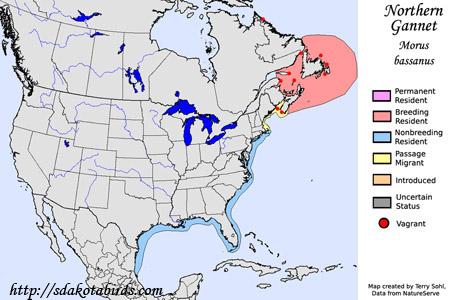 |
| South Dakota Status: Non-resident in South Dakota |
Additional Northern Gannet Photos
Click for a higher-resolution version of these photos
